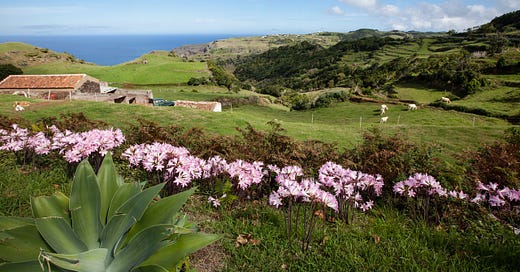The Everest of Portugal
Greenland, Panama, the Faroe Islands, Azores, and Canada have all been in the news as potential points of interest of unsolicited American expansion. But this isn't about politics—it's about geography. I'm surprised by how few North American divers visit this Atlantic treasure. Time and again, I'm asked the same question: "Where are the Azores, and why do they matter?"
The Azores, an autonomous region of Portugal, is a chain of nine volcanic islands scattered along a hot spot in the North Atlantic, roughly 1,300 km west of continental Europe and nearly 2,000 km southeast of Newfoundland. This remote archipelago offers a perfect blend of European charm and the laid-back rhythm of island life. Rising from the confluence of three tectonic plates along the Mid-Atlantic Ridge, the seamounts of the Azores form what would be the world's tallest and steepest summits. Nestled within the Gulf Stream, they enjoy a mild climate with daytime highs typically between 16°C and 25°C, and water temperatures warm enough to invite exploration in every season.
The Azores have long served as a strategic resupply point for travelers of all kinds. Ancient mariners stopped here to provision their ships, early trans-Atlantic flights landed to refuel, and military forces coveted the islands for their bases. Today, marine mammals also take advantage of these rich waters, treating them as a rich buffet on their migrations between the warm seas of Africa and the feeding grounds of Iceland, Greenland, and beyond.
Remarkably, 25% of the world's known marine mammal species have been spotted in the Azores. Sperm and pilot whales call these waters home year-round, using the area as a nursery. Numerous dolphin species are regular visitors, while late spring and early summer bring migrating baleen whales, feasting on plankton, krill, and herring that flourish during the seasonal plankton blooms.
Beyond its marine life, the Azores offer thrills for the adventurous. Zip lines, mountain bike trails, rainforest hikes, caving expeditions, and gourmet meals cooked in volcanic baths draw tourists from across Europe. Yet, it is the unparalleled diving that remains the cornerstone of tourism.
On São Miguel, the air carries a soothing blend of incense and salty sea breeze, setting the tone for a life that moves in an unhurried, deliberate rhythm. Diving is efficient and exhilarating, with Rigid Hull Inflatable Boats (RHIBs) whisking divers to nearby sites even in challenging seas. Beneath the surface, São Miguel offers a world of geological wonder. Divers can explore a bubbling underwater cocktail of volcanic gases released from natural hydrothermal vents or descend to historic wrecks like the Liberty ship Dori. The island's dramatic sea mounts feature walls, lava arches, and caverns teeming with life. From tiny seahorses and nudibranchs to majestic groupers and graceful mantas, São Miguel promises unforgettable diving.
Santa Maria's mountainous terrain is a stunning blend of lush rainforests, quaint fishing villages, and historic lighthouses. Yet, for many visitors, the island's true allure is found in the crystal-clear waters shimmering with an otherworldly radiance. The island's underwater preserves are fiercely protected, allowing marine life to flourish and offering small groups an intimate, eco-friendly experience. Just 5 km offshore, a large mooring ball rises from the summit of a seamount where schools of barracuda form shimmering curtains, and convoys of mobula rays glide by in graceful arcs. Their enormous wings outstretched, the rays appear to revel in the sensation of exhaust bubbles tickling their bellies—a mesmerizing dance in the gentle rhythm of the ocean.
Beyond diving, the Azores hold global strategic importance, supporting undersea cable networks, maritime traffic, and NATO operations at Lajes Field on Terceira Island. The archipelago extends the European Union's influence over a vast exclusive economic zone rich in resources, while its location aids in climate monitoring, ocean research, and search-and-rescue efforts. Balancing eco-tourism with sustainable practices, the Azores is a crucial hub for geopolitical strategy and environmental preservation.
This newsletter is 100% organic - no algorithms, chatbots, or artificial sweeteners - just original thoughts and stories from cave diver Jill Heinerth and culturalist Robert McClellan. Subscribe for free and enjoy!
Hey, guess what? On Monday, January 20th, we created a podcast sharing our thoughts and insight regarding the new Trump 2.0 administration and how it will influence the lives of “everyday people.” Needless to say, we received a lot of comments and feedback from our listeners - most of it surprisingly positive. Here’s a link to the Apple Podcast version of the Into The Planet Podcast. The next few years in the United States may prove challenging for some - and a welcome change for others, depending on their societal and political point of view. As far as Jill and I are concerned, we will continue to share our positivity, hope, and curiosity through civil discourse here at The Explorer’s Mindset. As always, we invite your feedback and comments. All good things - Robert
Remember to share the love - and your milk shake!
As our Southern U.S. readers shovel themselves out from under a snowstorm (!) we remain in Portugal for another week, escaping our dark Canadian January. Please be safe, be careful driving, and look after your neighbor!
We feel you…








We absolutely LOVE Portugal!
A beautiful portrait of my country! Unfortunately I haven’t had the chance to go to Azores just yet, but I’m definitely looking forward to it